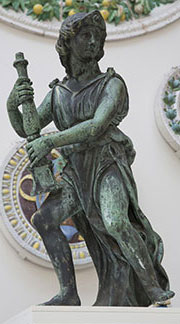The List: Cardinal Wolsey’s lost treasures
Roula Khalaf, Editor of the FT, selects her favourite stories in this weekly newsletter.
The Victoria and Albert Museum has just launched a £2.5m fundraising campaign to buy four bronze angels commissioned in 1524 by Cardinal Thomas Wolsey (c1475-1530) for his tomb. After Wolsey fell out of favour with Henry VIII in 1529, the angels were confiscated by the king before being sold. In 2008, two were found at Harrowden Hall in Northamptonshire, where all four had once stood above the gateposts. Here are four of the other painful losses Wolsey suffered after his fall from grace.
1. Christ Church, Oxford
The college was founded by Wolsey as Cardinal’s College in 1524. “This was going to be the most expensive, lavish Oxbridge college ever seen,” says Diarmaid MacCulloch, professor of the history of the Church at Oxford university. “What we have now is a pale reflection of what he wanted, despite Christ Church being one of the grandest colleges in the world.” Wolsey was devastated at the thought of his college being destroyed. “There was a terrible spite about Henry,” says MacCulloch. “In 1529 he told Wolsey he could keep the college but rename it the King’s College.” Henry later made the chapel of Wolsey’s lost college into a cathedral and it became Christ Church.
2. Wolsey’s Gate, Ipswich

A small brick gateway beside St Peter’s church in Ipswich is all that remains of Wolsey’s plans to build a college in his home town that would be even more extravagant than the one in Oxford. In 1532, after his death, all building materials for the college were taken to be used for the king’s extensive building works in London.
3. Nelson’s Tomb, London
A black marble sarcophagus now on Lord Nelson’s tomb in the crypt of St Paul’s Cathedral was part of a tomb Wolsey originally planned for himself. “Henry very dramatically confiscated all the parts of Wolsey’s tomb and said it would be for him instead,” says MacCulloch. When Henry died, the sarcophagus was taken to his burial place at Windsor Castle but the sarcophagus remained unused at Windsor for 300 years before forming part of Nelson’s tomb.
4. Tapestries at the V&A
Wolsey spent vast sums on tapestries and owned more than 100, all taken by the king after the cardinal’s fall. Alden Gregory, assistant curator at Hampton Court Palace, says one of the most interesting pieces, now in the V&A, is “The Triumph of Fame over Death” based on Petrarch’s The Triumphs. Wolsey had portraits of himself and Henry VIII stitched into the design.
For details on the campaign to save the Wolsey angels, visit vam.ac.uk
Photograph: Victoria and Albert Museum
Comments